

Designing Voyager’s Bridge

After decades of Star Trek , the bridge of a Starfleet vessel is an instantly familiar place to almost any television viewer.
When Richard James was tasked with the production design of Star Trek: Voyager , however, he decided to push the boundaries. Did the bridge really have to be dominated by a large viewscreen in the front? Could command functions be decentralized? Was it time to break the traditional bridge mould?
James asked for concept sketches from set designers, illustrators and scenic artists, including Louise Dorton, Gary Speckman, Doug Drexler, John Chichester and Jim Martin. Because Voyager would be smaller, sleeker and faster than the Enterprise -D, he requested designs that felt more like a military ship. His basic instruction was: “look at everything. No concept is too far out.”
“I just wanted to feel like we’d explored all avenues by the time we came up with the finished design,” he told Star Trek: The Magazine for its November 2000 edition.
I wanted to feel a certain satisfaction that other avenues had been explored. We arrived at the ‘look’ we have for certain reasons, not just because it was the only thing we considered — which it wasn’t. We went through the gamut of ideas and concepts.
But the further afield he went, the more it confirmed the designs “just weren’t Star Trek .”

As Garfield and Judith Reeves-Stevens elegantly put it in The Art of Star Trek , James “rediscovered the strengths of the basic template laid out by Matt Jefferies almost thirty years earlier.”
For example, that a TV audience relates to the viewscreen like a car windscreen and that it makes sense to point characters at it, even if, in-universe, there is no reason why the bridge should have a back and front.
Like the bridge of the Enterprise -D, Voyager ’s was given a layered appearance. But unlike the “D”, which had two levels and a smooth transition between them, Voyager got three levels and connecting steps. Add to that Voyager ’s grey colors, as opposed to The Next Generation ’s sand-colored chairs and red carpet, and the new series ended up with an altogether more functional look.
The interior sets for Voyager were built literally in place of The Next Generation ’s, on Paramount’s Stages 8 and 9. Picard’s ready room became Voyager ’s conference room; Ten Forward Voyager ’s mess hall. Engineering, sickbay and the transporter room were all upgraded versions of the sets built for The Next Generation , which were themselves updated versions of the sets first erected for Star Trek: Phase II and The Motion Picture in 1977.


Paramount Stage 9
- View history

Paramount logo found at the intro of many Star Trek films
Paramount Stage 9 is located on the Paramount Pictures lot in Hollywood, California.
Stage 9 was used in most Star Trek productions including the first seven feature films , Star Trek: The Next Generation and Star Trek: Voyager .
It was used through the four-year run of Star Trek: Enterprise and also housed sets for the 2009 film Star Trek .
- 1 1977-1986
- 2.1 Break-in
- 3 1994-2001
- 4 2001-2005
- 6 Productions
- 8 External links
1977-1986 [ ]
During its 1977 pre-production, sets for Star Trek: Phase II were slated for construction and permanent use on Stage 9.

Main bridge from Star Trek VI: The Undiscovered Country

Main engineering from Star Trek: The Motion Picture
Most of Phase II 's sets were completed when that series gave way to production of Star Trek: The Motion Picture , at which point they were modified and expanded for use in the feature film.
Stage 9 contained the primary interiors of the refit Enterprise and the USS Enterprise -A including the main bridge , transporter room , sickbay , corridor complex , Captain Kirk's cabin , and engineering .
Paramount Stage 8 housed the rec deck of the Enterprise , seen in The Motion Picture .
After the first feature, the dilithium chamber was added to engineering for the climax of Star Trek II: The Wrath of Khan . The sets remained mostly unchanged for Star Trek III: The Search for Spock .
The stage was used through Star Trek IV: The Voyage Home for Bird-of-Prey and Enterprise -A interiors, until it was taken over for permanent use in Star Trek: The Next Generation .
1987-1994 [ ]
In 1987 , with the start of Star Trek: The Next Generation , the sets on Stage 9 underwent modifications to become the USS Enterprise -D , the most drastic of which being the overhaul of the engineering and main bridge sets – the latter becoming the battle bridge .
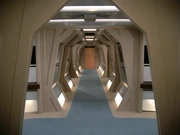
Corridors from Star Trek: The Next Generation
Edward K. Milkis and Robert H. Justman viewed the existing film sets for the first time in October 1986 to determine what could be reused for the new series. They found the sets in poor shape due to damage caused by cats living on the stage. ( Star Trek: The Next Generation Companion (3rd ed., p. 8))
With new bridge and living quarters sets being constructed on Stage 6 for season one , Stage 9 contained the Enterprise -D's engineering, sickbay, crew quarters, transporter room, shuttlebay , and corridor complex sets. Other sets included the fullsize shuttlecraft mockups and interiors.
Sickbay doubled as the observation lounge : the observation lounge windows were covered with carpet during the sickbay scenes. A new conference lounge was built on Stage 8 for season two . ( Star Trek: The Next Generation Companion (3rd ed., pp. 10 & 65))
Space across from the transporter room was saved for swing sets such as Troi's office and the battle bridge doubled as Data 's lab and other locations, on and off the Enterprise .
Stage 8 housed the remaining Enterprise -D interiors used post TNG Season 2 and Generations .
Over the seven season run of TNG, the sets were refined – the corridors were expanded for longer tracking shots – but remained mostly unchanged even through the production of the seventh feature, Star Trek Generations .
The vast TNG interior sets were redressed for the final two original series movies, Star Trek V: The Final Frontier and Star Trek VI: The Undiscovered Country in 1988 and 1991 respectively.
Temporary sets filmed on Stage 9 included the Rutian plaza in the episode " The High Ground " as well as scenes aboard the Talarian observation craft in the episode " Suddenly Human ", filmed on 27 July 1990 . Stage 9 also housed the workout room seen in episodes such as " Clues ", filmed on 29 November 1990 . The Tamarian bridge seen in the episode " Darmok " was built on Stage 9, filmed on 24 July 1991 and 25 July 1991 .
Break-in [ ]
On 10 January 2007 , a user on the video sharing website YouTube posted four videos entitled Stage 9 Interlopers
Consisting of four parts, the videos were shot on the night of 10 March 1988 by (at least) two fervent Star Trek fans who had broken onto the Paramount lot. Wandering through the darkened sets of Star Trek: The Next Generation (circa season one), the fans were able to light select parts of the sets, including most of the ship's display terminals and part of the warp core . Dressed in a makeshift Starfleet uniform (with white socks), one of the fans acted as the host of what was likely intended to be a homemade documentary – at one point climbing onto a sickbay biobed , then accidentally knocking it to the floor. Taking still photographs of the various "working" control panels, the fans can be heard discussing ways of removing set pieces from the stage.
According the YouTube user's description of the videos, when the fans were caught, they dropped the camcorder containing the footage and fled. [1]
1994-2001 [ ]
After their use in Generations , the sets on Stage 9 underwent yet another revamp for their debut as the USS Voyager . ( Star Trek: The Next Generation Companion (3rd ed., p. 321)) Richard James used his TNG experience and designed the Voyager sets to be easier to film than previous ones. ( A Vision of the Future - Star Trek: Voyager , page 91)
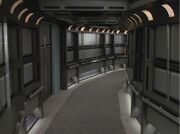
Corridors from Star Trek: Voyager
As on TNG , Stage 9 housed engineering, sickbay, transporter room, junior officers' quarters, the corridor complex, and the shuttlebay/cargo bay/holodeck. A large science lab was eventually constructed here as well. ( A Vision of the Future - Star Trek: Voyager , page 83)
While most sets retained their general positions, the Voyager engineering set was dramatically expanded, gaining a large second level. In its previous incarnation, engineering stood as part of the corridor complex and was often modified to represent a junction or living area. The revamp for VOY corrected this problem by making engineering its own compartment – a permanent standing set.
Sickbay was joined by a small biomedical laboratory for the second season , to the consternation of some crew members who felt the space would be better utilized for production storage. ( A Vision of the Future - Star Trek: Voyager , page 91)
Stage 8 housed the remaining Voyager interiors used in VOY.
In 1996 , Voyager 's sickbay was modified for use in Star Trek: First Contact and again in 1998 for Star Trek: Insurrection . The entrance to main engineering also represented the USS Enterprise -E 's library, while the transporter room was also reused and slightly redressed.
For the second season episode " Resistance ", Stage 9 housed the set of Caylem 's shelter. The scenes were filmed on Monday 25 September 1995 and Tuesday 26 September 1995 .
On Monday 2 April 2001 , Stage 9 housed the sets for the cave interiors, jungle sets, and rocky side areas during second unit for the seventh season episode " Natural Law ".
The science lab set was the first standing Voyager set on Stage 9 to be demolished, on 22 March 2001 . Tuvok's hospital room from " Endgame " was constructed in its place. Engineering was dismantled over 29 March 2001 to 5 April 2001 . Demolition started on the cargo bay set on 5 April 2001 as well. ( Star Trek: The Magazine Volume 2, Issue 4 , pages 69-71)
2001-2005 [ ]
In 2001 , following the end of Voyager 's final season , all of the sets in Stage 9 were permanently removed.
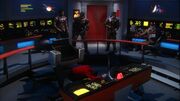
Star Trek: Enterprise , " In a Mirror, Darkly "
Instead of being home to the interiors of Enterprise NX-01 for Enterprise , Stage 9 housed only that series' cave set and various swing sets. Paramount Stages 18 and 8 housed all of the NX-01 interiors used in Enterprise .
Stage 9 housed the following sets:
- Captain's mess ( ENT : " Terra Nova ")
- Terra Nova underground tunnels , caves , gutting room , and well ( ENT : " Terra Nova ")
- Underground catacombs , stairwell , archway, meditation room, and reliquary at the monastery at P'Jem ( ENT : " The Andorian Incident ")
- Surface of Archer's Comet ( ENT : " Breaking the Ice ")
- Shuttlepod 1 interior, Akaali forest clearing , and basement mine control room and stairwell ( ENT : " Civilization ")
- Risan bistro, nightclub, and basement under the nightclub and Hoshi Sato's apartment ( ENT : " Two Days and Two Nights ")
- Rura Penthe ( ENT : " Judgment ")
- Bridge of the USS Defiant ( ENT : " In a Mirror, Darkly ", " In a Mirror, Darkly, Part II ")
- Rigel X ( ENT : " These Are the Voyages... ")
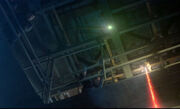
Stage 9 roof in " These Are the Voyages... "
The ceiling of the stage was actually seen in the scenes of " These Are the Voyages... ", as it was deemed a good fit for the interior of the complex.
Stage 9 was home to the mines of Remus in 2002 for the filming of scenes from Star Trek Nemesis .
Following the cancellation of Enterprise in 2005 , Stage 9 was, for the first time in many years, put into use in non- Star Trek productions.
According to a May 2007 news item from The Trek Movie Report website, J.J. Abrams ' 2009 film, Star Trek , was – in part – filmed on Paramount's Stage 9.
Set construction was scheduled to take place in July 2007 , utilizing other "historic" Star Trek sound stages including Stages 8, 11 , 14 , 15 , and 18. [2]
Productions [ ]
- Star Trek: Phase II
- Star Trek: The Motion Picture
- Star Trek II: The Wrath of Khan
- Star Trek III: The Search for Spock
- Star Trek IV: The Voyage Home
- Star Trek: The Next Generation
- Star Trek V: The Final Frontier
- Star Trek VI: The Undiscovered Country
- Star Trek Generations
- " Caretaker " ( Val Jean Int., Transporter room, corridors, Kazon bridge, Cardassian bridge, Neelix' junk ship, Neelix' Quarters and bathroom, sickbay, Mark's House, Engineering)
- Star Trek: First Contact
- Star Trek: Insurrection
- Star Trek: Enterprise
- Star Trek Nemesis
- Star Trek ( 2009 )
Sources [ ]
- Judith and Garfield Reeves-Stevens , Star Trek Phase II: The Lost Series
- Stephen Edward Poe , A Vision of the Future - Star Trek: Voyager
- Michael and Denise Okuda , Star Trek Nemesis (Special Edition) text commentary
- Michael Okuda, A Brief History of Paramount Stages 8 & 9 , StarTrek.com [3] (X)
External links [ ]
- Paramount Pictures – official website
- StarTrek.com , the official Star Trek website
How a Set Fire Led to Star Trek: Voyager's Funniest Episode
A fire damaged the bridge set on Star Trek: Voyager, the writers went to the holodeck for 'The Bride of Chaotica,' one of series' funniest episodes.
- "The Bride of Chaotica" is considered to be Star Trek: Voyager 's funniest episode, and it was created because of a fire on the bridge set.
- The holodeck, which creates realistic virtual environments, is frequently used in Voyager, often for romantic storylines or character development.
- Lieutenant Tom Paris's fascination with 20th-century culture and technology led to the creation of the hilarious holodeck program, "The Adventures of Captain Proton."
While Star Trek is perhaps most known for its inclusive vision of the future and biting social commentary, that's not all is. As much as fans love the drama in the franchise, humor is an equally important part of its creative DNA. On Star Trek: Voyager , the fifth season episode "The Bride of Chaotica" is arguably the series' funniest, and it mostly exists because of a fire on the bridge set. A light-hearted holodeck romp, it's both a loving homage to old sci-fi and a brilliant send-up of Star Trek itself.
While most people think the holodeck was created for Star Trek: The Next Generation , it actually first appeared in The Animated Series . Essentially the next evolution in virtual reality, the futuristic holographic technology creates real environments, down to people, the crew can talk to and even touch. Where Star Trek: Voyager is concerned, the holodeck usually means an episode where Kate Mulgrew's Captain Kathryn Janeway explores a little romance. The decision was made early on that, unlike Captain Jim Kirk, Janeway would not delve into romance, especially dalliances with the crew. In later episodes, ex-Borg Seven of Nine uses a holographic recreation of Voyager and its crew to "practice" social skills and learn to be more human. Yet, the best use of the holodeck comes from Lieutenant (sometimes Ensign) Tom Paris, and his fascination with 20th Century culture and technology. He creates a holo-program called The Adventures of Captain Proton , where he plays the titular hero and faces off against the villainous Doctor Chaotica.
Voyager's Tom Paris Was Fascinated By 20th Century History And Culture
Star trek: voyager's seven of nine and chakotay romance was a mistake.
The Tom Paris character was based on Nick Locarno , an antagonist from Star Trek: The Next Generation recently brought back for the Season 4 finale of Lower Decks . He began as an irascible, formerly incarcerated character and eventually became a vital part of the crew. Paris had an affinity for 20th Century culture and technology. Originally included so the storytellers could reference the then-present, it led to Captain Proton.
"When it was just decoration it felt…gimmicky," actor Robert Duncan McNeill said in Star Trek Voyager: A Celebration , adding, "I thought [Captain Proton] was a little more emotionally character-connected to Tom's love of the 20th Century" than just the odd reference or knick-knacks in his quarters. It was introduced in the Season 5 premiere episode, "Night," but the cast and writers wanted to revisit the setting in a future episode.
Actor Martin Rayner played the holographic villain Doctor Chaotica , finding the perfect balance between committing to the role and over-the-top hammy acting. (Appropriate for the early 20th Century sci-fi serials they were parodying.) He was joined by his hapless dunce of a henchman, Lonzak, played by the late Nicholas Worth. Yet, the most unique (and risky) thing about the Captain Proton program was the whole thing was shot in black-and-white — a risk because 1990s channel surfers who might otherwise stop and watch Star Trek: Voyager could skip past the show thinking it was an old-school hokey sci-fi film.
A Fire On The Voyager Bridge Sent The Crew To The Holodeck
Star trek: lower decks just simplified voyager's biggest moral dilemma.
With 26 episodes to produce each year, the writers, directors, and cast of Star Trek: Voyager were always looking for a concept that could be repeated. Because the USS Voyager was traveling (throughout the series) 75,000 light-years back to the Alpha Quadrant and Earth, alien planets and culture could rarely be returned to. However, the holodeck went everywhere the ship did, and so Captain Proton, Lonzak and the hilariously named Satan's Robot could. The accidental fire on the bridge set forced the producers' hands.
On the Voyager rewatch podcast The Delta Flyers , hosted by McNeill and Wang, the full story of the fire is told for the first time. Producers used to cater lunch for the cast and crew on Fridays, and Wang and Neelix actor Ethan Phillips were eating their food at a picnic table overlooking the bridge. Executive Producer Rick Berman was also on set at the time, standing behind one of the ship consoles for a photo shoot for the now-defunct Yahoo! Magazine .
"The lights that were lighting this photoshoot," Wang says, "caught…that fabric we had over top of the bridge…on fire." Wang had his back to the set, but Phillips could see what was going on. His eyes grew wide, and he asked Wang if "the bridge was supposed to be on fire." They stood up and altered the crew as Berman ran clear of the blaze. Members of the crew grabbed fire extinguishers and put out the flames, but the damage done to the set was significant. Thus, "The Bride of Chaotica" came about as a way to shoot an episode primarily on other sets.
Why 'The Bride Of Chaotica' Was Voyager's Most Fun Episode
Janeway's coffee addiction on star trek: voyager is not the fault of the writers.
The premise of the episode involved the ship getting stuck in a sci-fi anomaly and creating a portal to a dimension populated by "photonic aliens." They visit the holodeck, believing the over-the-top characters to be life forms. Since Doctor Chaotica is evil, a very real war broke out between his Army of Evil and these aliens. However, the threat to the ship and the crew was very low, allowing the characters to lean into the silliness and fun of the episode. Mulgrew, for example, plays Arachnia the Spider-Queen, Chaotica's titular bride.
Despite thinking the whole thing is silly, Janeway eventually allows herself to get into the spirit of the game. The scenes in which Paris and Kim have to explain the Captain Proton program are hilarious, especially because the background cast seems barely able to contain their laughter. In the podcast, Wang notes Paris's explanation of the story is reminiscent of what it must sound like when Star Trek fans try to explain things like warp drive, transporter clones, and the other more out-there concept to those who don't know the show.
It also allows for plenty of in-jokes about Star Trek , like its obsession with caves . While walking through a cave set, Kim asks Paris why the planet looks like another one from an earlier chapter in the Captain Proton story. "Set were expensive," he says, a clear reference to Star Trek reusing the "Planet Hell" set over and over again across all the second wave shows. Since the ship is in no real danger, the characters can play the adventure for comedy instead of dire stakes. Both Wang and McNeill believe this was the episode the cast had the most fun doing.
Captain Proton Was Star Trek's Greatest Holodeck Program
Star trek: voyager predicted the ai debate - with a clever twist.
Beyond the comedy and the joy in the cast performances, Captain Proton, Doctor Chaotica, Satan's Robot, and all the rest represent the best use of the holodeck. (All due respect to Deep Space Nine's Vic Fontaine .) All too often, to create tension and stakes, the storytellers relied on malfunctions to make the harmless fun of the holodeck into something more lethal. What makes the Captain Proton episodes, particularly "The Bride of Chaotica," so fun is that they are never dangerous.
The lack of stakes allows the cast to play their roles for comedy while honoring the origin of Star Trek . The sci-fi serials and films of the early-to-mid 20th Century not only inspired Gene Roddenberry (if only to make Star Trek different), but they also inspired that other "Star" franchise. In fact, George Lucas wanted to make a Flash Gordon film but couldn't get the rights. So, he told his own story built on those foundations, giving the world Star Wars . Captain Proton honors that legacy and, at the same time, pokes fun at the more outlandish tropes.
Captain Proton and Doctor Chaotica could fly again, at least if Robert Duncan McNeill has his way. In the extended version of The Delta Flyers episode, he mentions that he actually pitched an idea for a podcast or animated special set in the "Captain Proton universe." He and Wang interviewed Martin Rayner who was delighted at the idea of getting to play Chaotica again. He told them when he encounters Star Trek fans they are passionate about his silly villain in ways that still surprise him. The concept and the characters are undoubtedly ridiculous, but there's also something about them that makes fans want more.
Star Trek: Voyager is streaming on Paramount+ and available to own on Blu-ray or DVD, and The Delta Flyers can be found on all podcast platforms or on Patreon.
Star Trek Voyager
Pulled to the far side of the galaxy, where the Federation is seventy-five years away at maximum warp speed, a Starfleet ship must cooperate with Maquis rebels to find a way home.
- More to Explore
- Series & Movies
Published Sep 15, 2017
A Day on the Discovery Sets
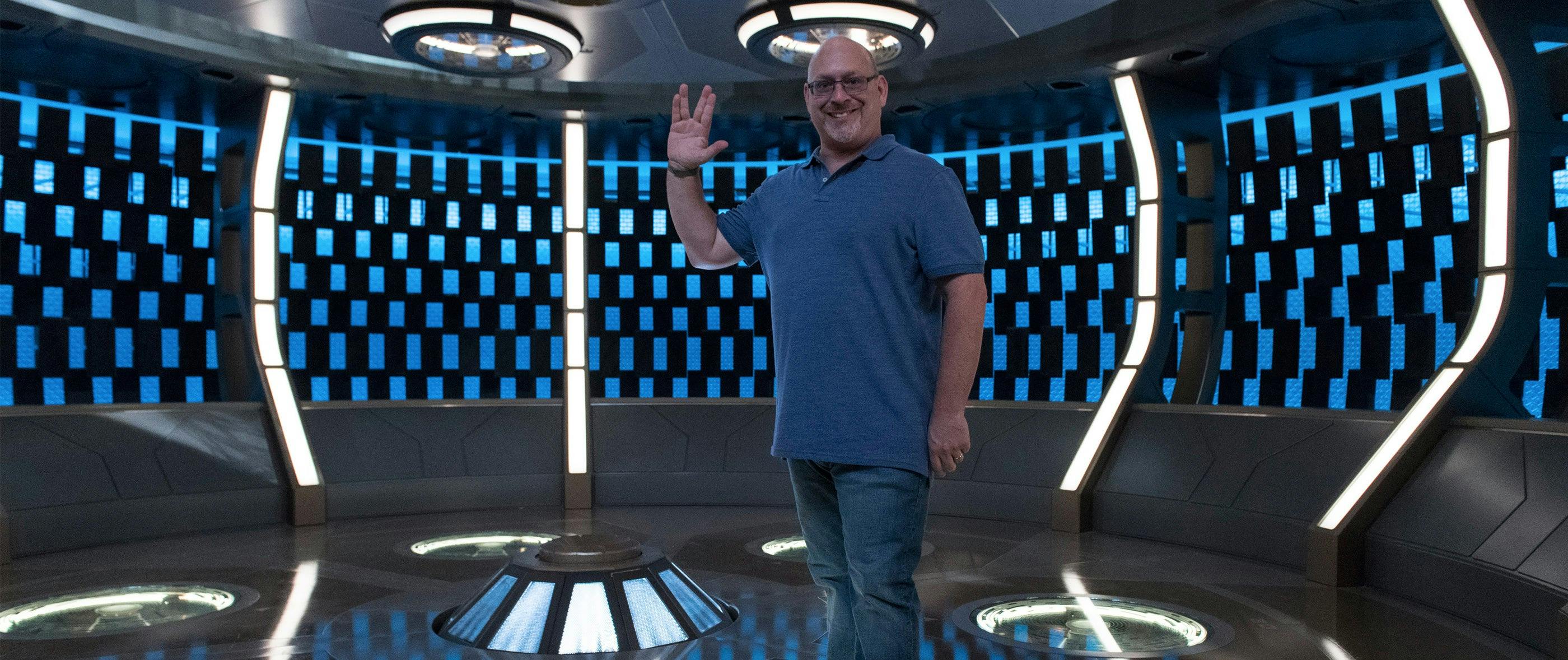
Stardate: August 21, 2017.
On this day, all across North America, millions of people trained their eyes on the skies above, as they checked out the rare total eclipse. Meanwhile, over at Pinewood Studios in Toronto, Canada, a couple of dozen journalists from outlets worldwide – including yours truly from StarTrek.com -- happily missed the eclipse in order to experience something even more infrequent: a visit to the sets of the upcoming Star Trek: Discovery series.
Now, let me put this in some perspective. Over the years, for New York Times Syndicate, Starlog , the official Deep Space Nine and Voyager magazines, as well as Star Trek Monthly , I’ve had the honor of visiting the sets of The Voyage Home, TNG, DS9, Voyager, Enterprise, Generations, First Contact, Insurrection and Nemesis . My visit to The Voyage Home set will never, ever be beat, as it was the day the cast and crew transformed the parking lot at Paramount into the San Francisco Bay, wind and lightning machines crackled and whirred, and Leonard Nimoy stood, in a white robe, megaphone in hand, orchestrating the chaos like a conductor as Shatner, Kelley, Takei, Nichols, Doohan, Koenig and Catherine Hicks stepped off a Klingon Bird-of-Prey and into the drink. That was pure, old-school Hollywood magic. I’d not visited the set of any of the J.J.-verse films, however, so I was stoked to see what was in store when it came to Discovery .
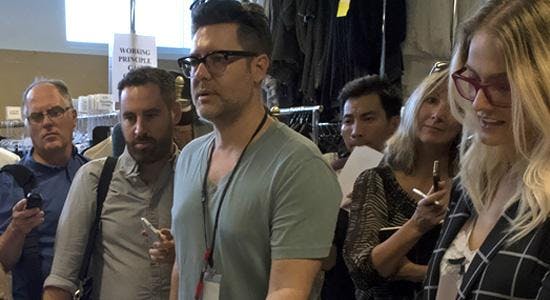
Aaron Harberts, Discovery 's executive producer and co-showrunner, proceeded to lead our group through an informative, time-efficient, well-structured Discovery set visit experience that started with us watching a bit of filming of a scene from later in the season. All in all, the production utilizes as many as eight stages at Pinewood, including the largest one in North America. Some sets, like the mess hall, which Harberts identified as one of his favorites (because interpersonal character stories play out there) were already down, while others were being erected right as we looked on; sorry, we’re not allowed to describe those! And, for the record, Brutalist architecture dominates everything, everywhere around here. Here are some highlights:
U.S.S. DISCOVERY
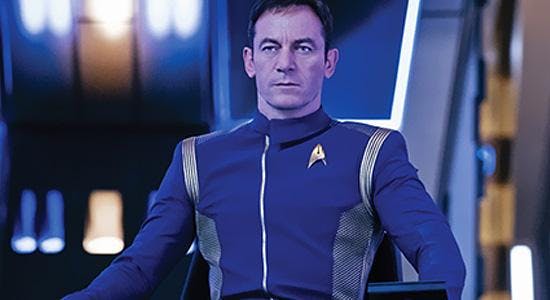
The U.S.S. Discovery bridge is a sight to behold. It’s sleek and clean and shiny. Oh, and massive. Size-wise, it’s worth noting, it seemed comparable to the Enterprise-D and Voyager bridge sets, as well as more colorful/less muted than both. The centerpiece is Captain Lorca’s chair, though he apparently hardly ever sits in it. He’s a standup guy, literally, and prefers to move about and get his hands dirty. But for the sake of providing an overview, assume Lorca’s chair is dead center. Just in front of him, to his left and right, are ops stations, and right in front of them is where audiences will see a viewscreen. But don’t get too used to viewscreens. Holographic projections will be the preferred method of communicating.
Right behind Lorca’s chair, on either side, are Burnham and Saru’s stations, and further along both sides are other crew stations. At the back of the bridge, there’s a turbolift and also Lorca’s super-spartan ready room. And lit monitors on the wall reveal the current state of the Federation-Klingon war; we’re not sure, but it doesn’t seem to be going well for the good guys.
A closer examination of some of the above reveals actual buttons and knobs on the assorted consoles. Harberts referred to it as “a little bit of analog stuff.” Conversely, the transparent screens at the crew stations are uber-high-tech. They’re monitors that are actually future televisions developed by a company and soon to become available to the public. The previous sets I’d been on had nothing like it, though the J.J.-verse sets likely did. “We’re trying to bring things up just a little bit so that we were living in our present-day language or what the future's going to be bringing us,” Harberts explained, “but also continuing to sort of stay nestled in those 10 years before The Original Series .” All of the graphics are pre-programmed, so if a character interfaces with the graphics, they will either do it in time with the graphics or the graphics will be burned in later during post-production.
ENGINEERING
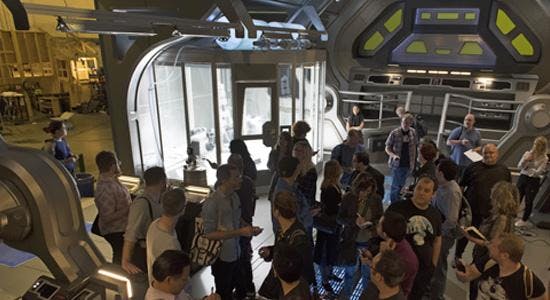
Anyone who has ventured up to Ticonderoga, New York, to check out The Original Series Set Tour surely marveled that the engineering room was far smaller than their imagination probably compelled them to believe. It’s the same thing up here in Toronto. Discovery 's engineering section is highly functional and there’s an enclosed, well-illuminated set called a “reaction cube.” Harberts suggested keeping an eye out for the reaction cube as events on the show unfold. “Engineering is a really important set for the show,” the executive producer noted. “Burnham and Tilly are here a lot. Stamets is often on the other side.” This set, FYI, was previously utilized as a torpedo bay. I’d seen that a lot on various Trek sets in the past, as the construction crews carefully and inventively redressed sets as required by the demands of a script, budgetary concerns and/or space limitations.
U.S.S. SHENZHOU
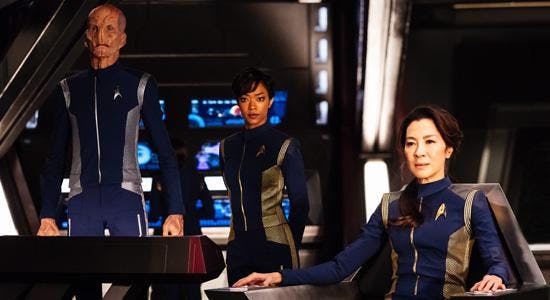
The Shenzhou is probably a brilliant set, but our group of intrepid visitors sadly did not get to explore it. For several reasons. One, construction work was being done on it. Two, it apparently takes many steps to reach and, once you’re inside, it features several sunken areas, stations the characters/actors must step down into, and more than a few people have bonked their heads or tripped, or both. Cue the blooper reel. Three, the entire Shenzhou set is raised, as the ship’s bridge is based at the bottom of the saucer section.
From our vantage point on the ground, though, it’s worth noting that the Shenzhou set faced a huge green screen/curtain. The Shenzhou is located on stage, #8, is Discovery ’s green screen stage. So, not only does the Shenzhou crew see space ahead of them courtesy of the green screen and subsequent VFX, but, for example, scenes set on Vulcan were shot in front of the green screen. Visiting this particular set reminded me of what I witnessed when I toured the First Contact sets. The Enterprise-E hull set, which would be walked on by Picard, Worf and Hawk, featured a huge green screen around and behind it, and the set pretty much filled a soundstage on its own.
“The Shenzhou feels almost more like a battle ship, even though it's a Starfleet vessel and intended for exploration, diplomacy,” Harberts said. “There's an intensity when you step onto this bridge. Not to say that Discovery isn't (intense, too), but the angles, the sharp lines, the ceiling kind of comes down to a much... The headroom there is a lot narrower. I would say it's almost more Hunt for Red October inside that bridge. It feels a little more cramped."
U.S.S. DISCOVERY CORRIDORS, TRANSPORTER & MORE
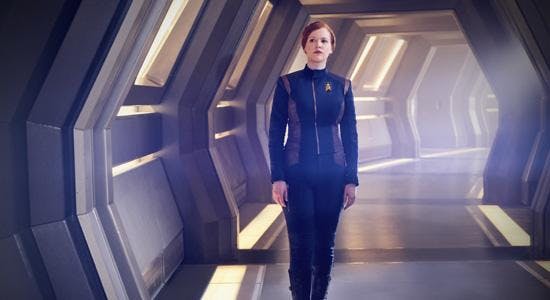
Stage #4, the aforementioned largest soundstage in North America, is home to pretty much all the major U.S.S. Discovery sets, except the bridge. There are the corridors, which are solid and feature guide lighting. The med bay is here, too, as is an airlock. So is the brig, which is, quite appropriately, a claustrophobic little space. As a veteran of Trek set visits, these all felt very familiar to me. Also here – and quite unique to anything I’d ever experienced -- was the quarters shared by Stamets and Culber. Harberts happily pointed out the bathroom and noted that the characters will share information about their respective days as they brush their teeth.
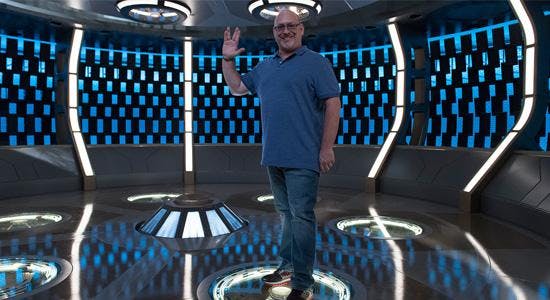
And then there's the transporter room. It’s every Trek fan’s dream to “energize,” and all of us visitors got our moment to stand on the transporter and flash the Vulcan greeting, grouse like Dr. McCoy or hum a beaming sound. This was one cool, elaborate set and, whereas the engineering room somehow felt small, this one feels enormous and wide open. I’d swear that, physically, it was bigger than I remember the transporter room sets from the various other Trek productions.
“This is another one of my favorite sets, just because it's so iconic, and it photographs so beautifully,” Harberts explained. “When you see our cast on the pads, you just can't help but get a rush. We switch this room back and forth between Discovery transporter room and Shenzhou transporter room. It's a huge switch."
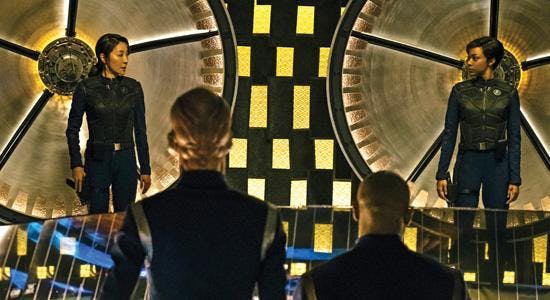
"The transport technology on the Shenzhou is different, is older, quote-unquote, so you'll see a different style of transport. The shower stalls, as we call them, echo more the TOS version. But we're in here quite a bit. Off to the sides, you have lockers for EV suits, phasers, pulse rifles, things like that, for landing teams.”
So, while a set is a set is a set, the Discovery sets were mighty impressive. They’re also highly, highly detailed, as HD cameras and HD televisions can -- and do -- reveal so much more than ever before. And, clearly, the permanent sets have been built to last, which signals that the Discovery team is thinking far beyond season one. May the show live long and prosper.
Star Trek: Discovery will debut September 24 on CBS All Access in the U.S. and Space Channel in Canada. The series will premiere on Netflix in the rest of the world on September 25.
Get Updates By Email
Explore the bridge of 'Star Trek: Voyager' through Oculus Rift
By Jacob Kastrenakes , a deputy editor who oversees tech and news coverage. Since joining The Verge in 2012, he’s published 5,000+ stories and is the founding editor of the creators desk.
Via Crackajack | Source Road to VR and Oculus VR
Share this story
:format(webp)/cdn.vox-cdn.com/uploads/chorus_asset/file/14692761/lss5jmu.0.1412046817.jpg)
The Oculus Rift has been used to transport people everywhere from Jerry Seinfeld's fictional apartment to another human's body , and over the weekend, one developer began taking gamers someplace even a bit further from reality: to the bridge of Star Trek: Voyager 's famous ship . The new virtual reality demo lets you walk around a fairly accurate recreation of the Voyager's bridge and even allows you to stare out into space as you whiz past distant stars. You'll be exploring the ship alone, however — unfortunately, no familiar crew members will be around for you to bump into, though you may just hear their voices off-screen.
"In a matter of minutes you can come up with an implementation that looks really amazing."
Road to VR believes that this is the first Oculus Rift demo from an independent developer that was made using the recently released Unreal Engine 4. Because the game engine includes support for the Rift , it could allow developers to create complex and graphically impressive virtual-reality worlds with an ease that wasn't afforded to them in the past. Speaking with Road to VR , the demo's developer, Thomas Kadlec, says just as much. "I almost have the sensation of being a 'movie director' when working with Unreal Engine 4," he says. "I can come up with an idea and in a matter of minutes you can come up with an implementation that looks really amazing."
We'll certainly continue to see developers use virtual reality to warp people into familiar fictional environments as they learn to code and create for the Rift and other VR platforms. As for why Kadlec started with the Voyager: "I’m a huge Oculus Rift fan, Star Trek fan, and Unreal Engine 4 fan," he tells Road to VR . "So I just figured I’d mix those all together!"
The MSI Claw is an embarrassment
New teslas might lose steam, the delta emulator is changing its logo after adobe threatened it, sugar’s big twist was more than a gimmick, behold ayaneo’s sophisticated takes on the game boy and game boy micro.
More from this stream From Kickstarter to Facebook: the full Oculus Rift story
Guess what i found in the oculus vr lobby a decade ago, the oculus rift goes on sale at best buy later this week, oculus rift preorder customers are facing months-long delays, oculus apologizes for shipping delays, will waive shipping fees for all orders to date.
Log in or Sign up
You are using an out of date browser. It may not display this or other websites correctly. You should upgrade or use an alternative browser .
Voyager Bridge Fire
Discussion in ' Star Trek: Voyager ' started by Adam Holmberg , Feb 8, 2008 .
Adam Holmberg Lieutenant Red Shirt
I recently read in another post...somewhere...that the Voyager bridge set was damaged by fire sometime in 1998 and had to be repaired/rebuilt. Anyone have any details? Which episode did the new set premiere in? Did it look any different? Any details would be appreciated.
Turbo Changeling Premium Member
I'm not sure what caused the fire, but I believe that it had something to do with the lights being left on too long. I do know that more damage was caused by the sprinklers than the fire itself. The damage wasn't severe, but couldn't be repaired quickly. It happened during the fifth season, and Bride of Chaotica! was moved up in the shooting schedule, as it only had a couple bridge scenes (which were filmed several weeks later). The first scenes shot on the repaired set were for Gravity (though the scenes for Bride of Chaotica aired first). If there were any differences, they weren't noticable on screen.
Lonestar Lieutenant Red Shirt
I seem to remember something about a star field back drop catching fire on another set that set off the bridge sprinklers, that might not have been Voyager though.
Katatak47 Commodore Commodore
I thought I'd read it was from lights used for an interview with Rick Berman on the set. One of the lights caught fire and caused all the damage. Can't remember if the show was on hiatus at the time of the incident or not.
- Log in with Facebook
- No, create an account now.
- Yes, my password is:
- Forgot your password?
- Search titles only
Separate names with a comma.
- Search this thread only
- Display results as threads
Useful Searches
- Recent Posts

Voyager Inconsistencies
Limited Supply Problems Other Problems The Nonsense of "Threshold" Star Trek Voyager Gothic
Limited Supply Problems
Voyager used to be the only Federation ship in the Delta Quadrant. This original premise was maintained through seven years. Alas, the authors were not consequential in taking into account the resulting limitations. New shuttles kept popping up as if the next starbase was around the corner, not to mention that the ship, despite all the power outages and the frequent skirmishes, was always in perfect shape (the real-world reason being that this allowed to use stock footage any time).
The development of the crew complement is investigated on a separate page.
Number of shuttlecraft
It may be due to a lack of better ideas why Voyager writers frequently had shuttles get into electromagnetic turbulences and crash on planets. Such an accident is no problem for starships that can simply be resupplied in a nearby starbase, but it is for Voyager. The official Star Trek Voyager Technical Guide V1.0 , intended as guidelines for writers (sub-title: "Yes, but which button do I push to fire the phasers?" ), curiously states that "Voyager normally carries two[!] standard shuttlecraft, four of the smaller shuttlepods, and four EVA workpods" . We have never seen any shuttlepods or workpods. The two lonely shuttlecraft were obviously both supposed to be of Type 6, since this one is depicted in the booklet. In any case a complement of two shuttlecraft was extremely short-sighted.
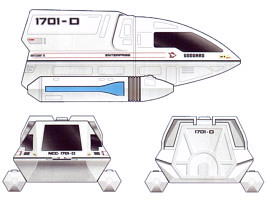
In strong contrast to what the booklet told the authors, lots of standard shuttles of no less than three different types, namely Type 6, Type 8 and Type 9 (the latter is designated as Type 12 in the Star Trek Fact Files and as Class 2 since the 5th season) were actually seen, and Voyager has probably lost as many as seventeen of them in the course of seven years:
Note that apparently minor damages with a few sparks and a bit of a fire inside the cabin are not included. It is evident that such a shuttle consumption is only possible if plenty of spare parts for repairing and assembling shuttles are available. We could imagine that most of the components of a shuttle are relatively simple, and can therefore be replicated. Still, very complex parts like the computer system, which employs quantum level computation, and the warp core would have to be stored. If the crew can build the highly advanced Delta Flyer from scratch, building new standard shuttles from existing plans and materials shouldn't be such a big issue anyway.
How many shuttles did Voyager really have at the beginning and how many were built afterwards? The aft section of an Intrepid-class vessel does not seem to be large enough to hold more than eight Starfleet shuttlecraft, and Neelix's ship, which seems to be somewhat larger, has to be stored somewhere as well. Fitting the Delta Flyer into the shuttlebay is still another problem (see also below ). In an optimistic estimation, we can assume that there were eight shuttles aboard when Voyager left for the Badlands. Since Voyager's complement consists of as many as three different shuttlecraft types, it is a good guess is that there were two shuttles of Type 6, three of Type 8 and three of Type 9. This means that at least seven new shuttles of different types must have been built from stored spare parts. Given Chakotay's incredibly funny statement of a "full complement of shuttles" in "Alice", all fifteen shuttles that were destroyed at the time must have been replaced, unless he counts the Delta Flyer as an equivalent of four or more shuttles.
Number of photon torpedoes
The original complement must have been 40, two of which were used to destroy the Caretaker Array, armed with tricobalt warheads. This leaves the 38 torpedoes that Tuvok counts in "The Cloud". He states that they can't be replaced. Nevertheless, the number of torpedoes used in the following exceeds 38 by far, even if we take into account only those which were seen or explicitly mentioned as being fired. The resulting lower limit is 93 torpedoes. Here is the complete list:
A possible explanation is that the crew has found a way to replicate the at least 53 extra torpedoes, which must have happened at least twice, some time prior to "Scorpion I/II" and some time prior to "Dark Frontier". Considering that a torpedo should be much less complex than a shuttle, let alone the Delta Flyer, this is a reasonable assumption if we accept the shuttle statistics. The only problem is Tuvok's premature pessimism about not being able to replace them.

Holodeck vs. replicator energy
During the first two seasons of the series, Voyager suffers from a permanent shortage of energy, which requires to ration replicator meals and obviously serves to justify the necessity of Neelix's kitchen. However, the holodeck seems to be in use the whole time, although this amusement arguably consumes much more energy than a small replicated meal, irrespective of the fact that most of the holomatter is usually recycled to energy. Moreover, the outside views show that almost all windows of Voyager are lighted, whereas most of the windows of the Enterprise-D were dark. Furthermore, all 15 decks have full life support. If I were a crew member, I would rather forgo additional luxury than my favorite food. The replicator rations are not mentioned any more in the third and forth seasons, while the crew are still enduring (or meanwhile enjoying) Neelix's cooking.
The usual explanation for the permanent operation of the holodecks is that they have an independent power source, as it was established in a few episodes and explicitly shown in "Night" were the hologrid was "frozen" when the computer failed. Seven said: "Independent subsystems are operational: environmental controls, holodecks." Anyway, what else should the allegedly independent holodeck power source be than a fusion or even a matter/antimatter reactor? What could be so special about them that they wouldn't be able to supply other systems too? Is there nothing like a simple "transformer" that could convert the plasma energy levels (i.e. the voltages) if they are different on the holodeck? Even if they are incompatible, the basic fuel (anti-)deuterium would be the same for all systems on the ship. So here is no reason to believe that if all other energy is gone, the holodeck can't serve as a spare power source. Much less is there a reason that fuel would be available for the holodecks, but not for the replicators.
Other Problems
The delta flyer.
The construction of the Delta Flyer within a few days, as seen in "Extreme Risk" , is a similar miracle as the transwarp shuttle in "Threshold" (see below ). Moreover, we need to wonder why it has taken four years until Janeway realizes that a larger auxiliary craft could serve Voyager much better than the small, slow and fragile standard shuttles that are frequently shot down or lost in magnetic storms. So if they could build the Delta Flyer in no time, why didn't they do it much earlier? Another problem is how the Delta Flyer is supposed to fit into the shuttlebay. Read about the Size of the Delta Flyer .
The aeroshuttle
"The bottom of the Primary Hull or saucer holds a single aerodynamic shuttle capable of atmospheric travel as well as interplanetary flight at speeds up to Warp 3. The AeroWing can carry various combinations of crew and cargo; the usual flight complement numbers four crewmembers." This is what the Star Trek Voyager Technical Guide V1.0 says about Voyager's version of the captain's yacht. The AeroWing, now called "aeroshuttle" was never mentioned, let alone shown on screen, though. Star Trek: The Magazine depicts details of Voyager's saucer bottom, showing the aeroshuttle. It is obviously intended to be a runabout-sized shuttle with its own maneuvering thrusters. So why was the aeroshuttle never used in six years, although it would have been an option so many times, considering situations in which a standard shuttle would have been too small or too weak? There are four theories:
1. The aeroshuttle was badly damaged at the very beginning of the show. I think this statement is hard to maintain, since everything was always repairable on Voyager, and building the completely new Delta Flyer seems more difficult. Even if the aeroshuttle were actually damaged beyond repair, it should have been mentioned at least at the time when it happened and several more times, something like "too bad we don't have the aeroshuttle". 2. They actually didn't need the aeroshuttle, or they wanted to preserve it. I don't think there is any reason to believe that, since Janeway didn't do anything to avoid dangerous situations in six years, so why should she be concerned about this auxiliary vessel? It is especially valuable? If so, why didn't they use this supershuttle at least for safe missions, or is it merely for decorational purposes? I think we may safely discard this idea. 3. The aeroshuttle actually doesn't exist. The shape on the bottom of the saucer is something else that accidentally resembles something like an independent shuttle or captain's yacht. This is actually the best excuse for not using or only mentioning the aeroshuttle. On the other hand, the Enterprise-D captain's yacht was not mentioned in seven years of TNG either although it definitely exists. Yet, the latter was only an unarmed oversized sublight shuttle supposed to ferry important diplomats. 4. The aeroshuttle does exist, but it wasn't aboard when Voyager left for the Badlands. The structure on the saucer underside is a hatch or some sort of cover that will be removed once the actual craft will be installed. But why would this cover have something that definitely looks like maneuvering thrusters?
Now that the aeroshuttle hasn't been resurrected even in season 7 (although there were plans), we can either say that it never existed, or it was just not installed when Voyager went on the short trip to the Badlands. Since we can't simply deny the shuttle-like structure on the saucer bottom, I like the suggestion that there was just a placeholder for the aeroshuttle or that the craft was not yet finished at the time of "Caretaker".
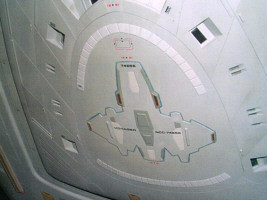
The escape pods
In VOY: "Workforce" the crew leaves the ship using the escape pods and are captured and turned into workers, save Kim, Chakotay, the Doctor, and eventually Torres is returned. During an attempt to save the rest of the crew, Kim asks Torres: "How many escape pods do we have left?" She replies "5" , and Kim says "eject 3 of them." The pods are captured by alien vessels, leaving Voyager with just 2 of originally 36 pods. The crew is rescued via transporters and it is safe to say the escape pods are not recovered. Considering that the crew assembled spare photon torpedoes and shuttles all the time and constructed two Delta Flyers, building 34 new escape pods does not seem to be a big deal. Still it is a stretch. Well, unless the pods are actually never replaced. We can't tell whether there are pods underneath the hatches or not.

The Maquis ship
The most important specifications of Chakotay's Maquis ship are uncertain, including its class, size and even its name. When Chakotay, Torres or other Maquis crew members talk about their time on this ship, we would normally expect them to call it by its name, but that never happens. The name "Zola" stated in the Fact Files never made it to the screen. The latest information on the class name comes from Star Trek: The Magazine . An article tells us of a desktop model of Chakotay's Maquis ship, as well as several displays of the ship where it is a Ju'day-class ship named "Val Jean". This can also be seen on a screen in "Repression". On websites the Maquis ship is sometimes classified as Peregrine courier. However, the Peregrine courier or fighter is more likely a considerably smaller vessel shown e.g. in DS9: "The Maquis" and also employed to distract the Cardassian fleet in DS9: "Sacrifice of Angels". Chakotay's ship (here named "Liberty") is classified as Antares class in the novel Pathways . There is a lot of confusion about this class name, which the authors are obviously too fond of. In any case this is only one of several theories.
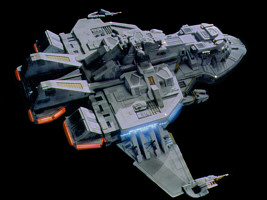
A diagram of the ship is depicted in the Star Trek Fact Files . The windows in the bridge section cannot be used as a reference, since they were not visible in "The Caretaker". The size of the bridge set, which seems to be only 5m wide, points to a very small ship of only 30m length. This complies with the size of the preliminary raider built for TNG: "Preemptive Strike" where there was a cockpit window instead of the bridge.
If on Voyager, as mentioned in "Repression", "almost a quarter of the crew is Maquis" , the minimum number of original crew members on Chakotay's ship would be 37, assuming that no one died during the transition to the Delta Quadrant. Three decks may be distinguished, but there are no windows or other details to confirm this. For a crew of 37, an overall length of 60m (for 3 decks with a height of 3m each) appears to be the minimum possible value, but only if there are no real quarters.
A half-way reasonable explanation for the big crew, considering that the small size of the ship is well established, is that the normal crew complement is significantly lower, at most around a dozen. The raider may have been manned with 37 or more Maquis because they were going to hijack a Cardassian ship, possibly a freighter, when the Galor-class cruiser foiled their plan and the Maquis had to seek refuge in the Badlands.
The warp nacelles
Voyager is the first ship to have foldable nacelles and pylons, at least the first one we know of. "Because Voyager employs a new folding wing-and-nacelle configuration, warp fields may no longer have a negative impact on habitable worlds, as established in TNG." This sentence from the Star Trek Voyager Technical Guide V1.0 is actually the only hint that the folding pylons may prevent the subspace damage of TNG: "Force of Nature". It was never mentioned on screen.
Another theory is that the efficiency of the warp field can be increased if it is continually tilted as the speed rises, in a similar fashion as on the F-111 and other aircraft with variable wing positions. However, the existing shots of Voyager in space don't make any sense, since only two angles of the nacelle pylons can be observed: 0° (horizontal) for impulse flight, and about 35° as soon as the ship goes to warp, remaining constant irrespective of the speed. While it makes sense for an aircraft to have just two wing positions for slow and for fast hypersonic flight, Voyager's warp drive is offline at impulse anyway, hence not requiring any specific nacelle position. It is not evident why the nacelles are folded up at all every time the ship goes to warp, and why they are not just fixed in the warp position.
Two warp cores?
Voyager's MSD clearly shows two warp cores (more precisely, two complete matter/antimatter reaction assemblies), one just behind the deflector dish, and one close to the kink of the hull undercut. Obviously one of them, the one we see in main engineering, is active all the time, while the other one must be a backup. Actually, the aft core is the main core, as we could clearly see in VOY: "Day of Honor" where it had to be ejected. The problem is that it was made a big deal in this episode (and again in "Renaissance Man") that this seemingly only warp core was essential and that the ship could not go to warp without it. But why didn't they just use the second warp core? After all, that is exactly what it was intended for. It is obvious that the second core may not be activated where it is stored but needs to be transferred to main engineering and connected again. But why would this be so much harder to accomplish with the backup core than with the main core that, in both episodes, Janeway doesn't even try it but rather sends shuttles against heavily armed ships to retrieve it?
Rick Sternbach, the ship's designer, once suggested that the second core was not supposed to act as a backup on stand-by, but that it would merely serve as a set of spare parts. Anyway, why would the ship carry only partial builds where it could have a complete core, and where the MSD shows something that looks like a complete core? It even makes less sense if we consider that usually Voyager would have been under way in the Alpha Quadrant. If the installation of the backup core were really that difficult and time-consuming, a repair ship or tug may have arrived to assist much sooner, so why have a spare core at all? Maybe the second core was irreparably damaged and even abandoned some time before "Day of Honor". Another possible explanation is that parts from the spare core that could not be replicated were already in use in the main core. Or, although this would be a stretch, perhaps the second warp core is designed to supply just the holodecks (see Holodeck vs. replicator energy above)?
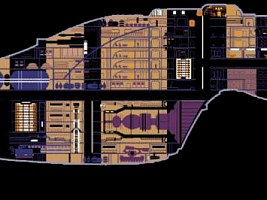
Transwarp coils
In VOY: "Dark Frontier" the crew trains to raid an active Borg cube to steal a transwarp coil, an extremely dangerous mission for a chance to get home much sooner. However, in "Unity" and "Collective" the crew has access to functional yet unoccupied cubes and yet don't bother to take a transwarp coil from either? In both episodes, although damaged, the cubes are still largely intact and no mention is made about the coils, functional or otherwise. We may explain the missed opportunity in "Unity", assuming that the crew may not yet have sufficient knowledge of Borg technology or of how to integrate it. At latest in "Collective", however, it is just stupid not to salvage the component.
The Beta Quadrant taboo
Following the flight path of Voyager, it is easy to notice that the Delta Quadrant is not directly adjacent to the beloved Alpha Quadrant, but that there is still the Beta Quadrant in between. After a journey of more than six years and some fast leaps (like 10,000ly with slipstream in "Timeless" and 20,000ly with the transwarp coil in "Dark Frontier"), Voyager should have crossed the border to the Beta Quadrant at latest by the sixth season - which is easy to reckon if we just subtract all the long and short leaps from the initial distance of 75,000ly. Nevertheless, the authors still kept the ship in the Delta Quadrant. The real-world reason was as obvious as it is silly: The people in charge thought they would confuse occasional viewers with too much galactic geography. Anyway, for a certain time it was still credible that Voyager was still in the Delta Quadrant, considering that some detours were necessary to avoid the Borg or large anomalies.
Still, it is unacceptable that the Beta Quadrant was mentioned only three times(!) in seven years, and only once as being on the route to the Alpha Quadrant. This is even worse considering that the Beta Quadrant as the home of Klingons and Romulans and a part of the Federation ought to play an important role. Even in VOY: "Message in a Bottle", where the Prometheus was hijacked by Romulans and was about to enter their territory, the dialogues all said "Alpha Quadrant" instead of "Beta Quadrant". The quadrant wasn't treated much better in DS9 either, for the galactic powers only struggled for the control of the "Alpha Quadrant" as if the Klingons and Romulans forgot where they came from. I wonder why the wonderful concept of four quadrants was first systematically introduced, only to be effectively discarded later.
The Nonsense of "Threshold"

Simulate the impossible?
The episode begins with Tom, B'Elanna and Harry simulating the Warp 10 flight. How is this possible? You can't simulate something that you deem impossible, and for which you have no equations and models that could describe a physical reality.
Transwarp hobbyists
Millions of engineers in the Federation have been working in vain on the development of transwarp technology for at least a century. Yet, a small team of three, on a starship with limited resources that has gone astray in the Delta Quadrant and is frequently attacked, succeeds in doing exactly this in their spare time. They work out a theory, design and build a prototype in a matter of one month. Yes, and I am sure in the 21st century the first nuclear fusion reactor will be built by the crew of a submarine while on an extended underwater mission. Well, Tom mentions something that serves to justify why the transwarp drive is being built right here and now: "We discovered a new form of dilithium in the asteroid field we surveyed last month. It remains stable at a much higher warp frequency." However, it is nothing more than a myth (unfortunately a recurring one on Voyager) that it only needs enough power to achieve previously impossible speeds with the same basic hardware, like you could break the sound barrier with a VW Beetle if only you had the right fuel.
Infinite speed - awfully fast
All official publications and even the episode itself unmistakably state that Warp 10 equals infinite speed and that, in one interpretation, "it means that you would occupy every point in the universe simultaneously" . Any infinite figure is merely hypothetical and may be dealt with in a mathematical equation, but never as a measurable physical quantity. Infinite speed is definitely impossible to achieve - even for Q. The dialogues in "Threshold" confirm it's impossible, still Tom achieves the impossible. One could object that Tom does not go to infinite speed, but just beyond the measuring limit. Yet, Tom states he has reached Warp 10, which we can expect to be backed by a measurement. Starfleet must be very accurate here, because there is a considerable (infinite!) difference between Warp 9.99999999 and Warp 10. Tom's "speedometer" may exceed its range of, let's say Warp 9.9999, but it would never say "Warp 10" or "infinite speed". It is also paradoxical how Tom, B'Elanna and Harry first explain to Neelix that Warp 10 is impossible, only to say they try it nonetheless, only to announce that Tom actually did reach Warp 10, only to wonder why he is gone from the sensors. This all doesn't fit together at all.
Fasten your seatbelts
If we nevertheless examine what would be necessary to reach Warp 10 in finite time, the acceleration would have to be infinite as well (with warp drive just as with any real technology). Infinite acceleration requires an infinite engine power output and, moreover, an infinitely strong IDF to keep the shuttle and passengers in one piece.
The barrier - even more than infinite
The "barrier" or "threshold" is mentioned in the episode title as well as in several dialogues. If Warp 10 means infinite speed, there is no such thing as a barrier or threshold to be broken. What could be more than infinite? A possible explanation: Since infinite speed is supposed to be achieved in finite time, there could be some kind of barrier indeed - namely the barrier where transwarp instead of normal warp becomes active. Beyond this barrier the acceleration could be much higher, yet not infinite. Anyway, from the dialogues we get the impression that the barrier is supposed to be exactly at Warp 10, and that "transwarp" in this case does not refer to the propulsion system but equals the velocity of Warp 10.
Where do you want to go today?
It is a nice thought experiment but a useless assumption put forward in reference works that a vessel moving at infinite speed would occupy all points in the universe simultaneously. Actually, it would just occupy all points along its trajectory at the time of reaching infinite speed, which has to be a straight line, for an infinitely short time. The trouble is that a straight line may get the shuttle back from where it started but probably not across the universe in all directions. The author, Michael DeLuca, or the script writer, Brannon Braga, obviously thought that the pilot of the Warp 10 shuttle would be able to travel to any desired point or return exactly to his starting point. But if the speed is actually infinite or at least high enough to overload the navigational sensors (dramatic blue shift), Tom can reach a certain region of space only by pure chance - a chance that is virtually zero. Tom, however, returns to a region of spece close to Voyager even twice after a Warp 10 flight. And aside from that, if he's everywhere at once, isn't that absolutely equivalent to being nowhere at all?
Don't forget your camera
Tom also brings lots of sensor data with him. The faster he goes, however, the more will the incoming light and any other form of waves be shifted to smaller wavelengths and also its intensity will increase, until harsh x-rays will finally burn the sensors as well as the rest of the shuttle along with Tom. We have to forgive Trek in general because, using real physics, this would already happen when approaching the speed of light. But warp physics are different, and somehow all inbound light is transformed to something visible and harmless during a warp flight. Unless this flight is infinitely fast. At infinite speed, the radiation intensity would be infinite and require an infinitely strong shielding. Here we go again. Even if he and his equipment survived at a still finite speed, the shuttle sensors wouldn't have been able to record anything but extremely intense x-rays. Or actually an absolutely homogenous omnidirectional finite radiation, owing to his being everywhere at once? It is mind-boggling but what is safe to say is that there is no chance that he could take any pictures of his flight. Tom, however, claims that he could even see what's happening on Voyager while he was at Warp 10. If this were true, his eyes and brain would have been able to isolate either a specific tiny portion from an infinitely big amount of visual impressions during the flight, or an infinitely small portion of a huge amount of impressions...
We're evolving to newts
Tom and later Janeway are said to have "evolved" to newt-like creatures crawling on the floor. Apart from the fact that such a creature can hardly be a species more advanced than a human being, evolution is a process that takes place over thousands, if not millions of generations, through mutation and selection. There can be no evolution within the same generation. It is much rather a random process under certain constraints than a program in our genes. Moreover, the result is always an adaptation to current environmental conditions. So even if Tom somehow evolved all alone, that would tell us that a newt is the optimum lifeform for a Warp 10 traveler. ;-)
Breathe or die
Why is Tom temporarily not able to breathe normal air during his metamorphosis, but only the strange poisonous gas? Why does he become allergic to water? This can hardly be a phase of his alleged evolution, since in nature there wouldn't be a well-equipped sickbay to support this.
Genetic magic
Agreed, we know similar procedures from TNG: "Identity Crisis", TNG: "Rascals", TNG: "Genesis" and VOY: "Faces". However, while the Doctor already had a hard time to restore Tom when he was only slightly mutated just after his Warp 10 flight, it is even more incredible that he succeeded to restore Tom and Janeway after virtually nothing of their DNA is left.
Anti-matter-dote
In order to restore Paris, the Doctor has a fabulous idea - how about feeding antiprotons from the warp nacelles into his damaged cells? Antimatter has been used for all sorts of barely credible purposes in Star Trek before. But dear Doctor, please keep it off your patients, unless you want them to act as a spare warp core or a photon torpedo!
Star Trek Voyager Gothic by quasi-normalcy @Tumblr
- You've been on this tiny ship in the Delta Quadrant beyond any hope of recrew or resupply for over a year, but you keep seeing ensigns you don't recognise. Everyone tells you that they've always been here.
- You go down to Engineering looking for Lt. Carey. B'Elanna tells you that he's just stepped out. He's been "just stepped out" for days.
- A shuttle crashes on a desert planet. You speak with Chakotay about the possibility of trading for some new shuttles, but he looks at you funny and says "but we already have a full complement of shuttles" .
- You run to the shuttlebay and inspect them personally. There is a full complement of shuttles. And none of them even have a scratch.
- The next week, a shuttle is torn to pieces in a plasma storm. You're not even surprised when you find intact it in the shuttlebay an hour later.
- You stop mentioning shuttles.
- The ship has an encounter with some Kazon, but manages to get away. Their ships are primitive and slow and you shouldn't run into them again.
- Two weeks later, you meet the same Kazon, now somehow in front of you. You begin to suspect that you're driving in circles.
- You go to Engineering looking for Lt. Carey. You haven't seen him in two years. He's "not there right now, but should be back in a minute" .
- Janeway and Paris travel at Warp 10 and turn into salamanders. You're *sure* that it happened. You *remember* it happening! But no one brings it up. When you ask Tom about it, he doesn't even register the question.
- You scream "BUT YOU WERE A SALAMANDER!" into his ear. He doesn't even hear you.
- You see another Ensign you don't recognise. You finally just ask the computer for the crew complement of Voyager. You are told that the answer is: 121.
- A month later, the Hirogen conquer the ship, spend weeks brainwashing and surgically altering the crew into believing that they are actually characters in holographic simulations, and then hunt them for sport. This culminates in a pitched battle between the crew and the Hirogen in which the ship is utterly wrecked and dozens of people are killed.
- Afterwards, you ask the computer for the ship's crew complement. You are told that the answer is: 147.
- The next day, you wake up and find Voyager restored to its original state.
- You make a discreet inquiry about Lt. Carey. Now everyone acts like he's dead but can't tell you precisely when or how.
- The Captain takes you aside one day and specifically instructs you not to mention Ensign Jetal to the Doctor. She says that she knows that this will be difficult, given how close we all were to her (and you in particular), but that for the greater good of the crew, you need to act like Ensign Jetal never existed. You solemnly nod your head and consent, and she gives you a comradely pat on the shoulder and leaves the room.
- You have absolutely no idea who Ensign Jetal is.
- Voyager absorbs the remaining crew of the USS Equinox. Well at least you'll finally have an explanation for the new crew you see around the ship! You never see any of them ever again.
- You've now travelled almost 40,000 light years towards home. You check the star charts; somehow, you're still in the Delta Quadrant. You begin to wonder if the Beta Quadrant even exists.
- The Delta Flyer is destroyed by Borg torpedoes. You don't even bother to check the shuttlebay for it, you just instinctively know that it will be back.
- A few months later, the Captain gives you the sad news: Lt. Carey is dead.
- You finally make it back to the Alpha Quadrant, say your tearful farewells, and receive a handshake and a promotion from Admiral Paris. As one last thought before leaving Voyager forever, you pay a visit to the shuttlebay. You find it utterly empty, except for one lowly crewman with a mop and pail, swabbing the deck. "I...guess that Starfleet must have already cleared out the remaining shuttles?" You say uncertainly, your voice echoing in the cavernous, empty room. The crewman breaks off his mopping and looks at you like you've lost your mind and says: "Voyager never had any shuttles."
Source: quasi-normalcy @Tumblr
Voyager's Crew Complement - casualties, crew count over time, crew appearances and names, other issues
Voyager Episodes index
Federation Shuttlecraft - and other small auxiliary vehicles
Size of the Delta Flyer - or: how to fit a 21m shuttle into a 14m shuttlebay
Warp Propulsion - 6 Warp Speed Measurement
Thanks to Christian for the facts about the "Beta Curse", to Andrew Jackson for the quote from "Night", to Timwi for suggesting that the second warp core feeds the holodecks, to Ter Loki for suggestions about variable warp geometry, to Stefan for annotations about the aeroshuttle, to Tim for a suggestion about the Maquis crew, to nixonshead for a remark about Doppler shift, to Dominic for a correction about evolution, to Ambassador for a quote from "Threshold", to Claudio Puviani for a note about "infinite speed" and to Waid for bringing up the transwarp coil and the lifeboat issues.

https://www.ex-astris-scientia.org/inconsistencies/inconsistencies-voy.htm
Last modified: 20 Sep 2023

© Ex Astris Scientia 1998-2024, Legal Terms
This website is not endorsed, sponsored or affiliated with CBS Studios Inc. or the Star Trek franchise.
Fleet Yards
- Intrepid Interiors
- VisualEditor
- View history
- Intrepid Long Range Science Vessel
- Bellerophon Long Range Science Vessel Refit
- Intrepid Long Range Science Vessel Retrofit
- Fleet Intrepid Long Range Science Vessel Retrofit
- Pathfinder Long Range Science Vessel
- Fleet Intrepid Long Range Science Vessel
- Legendary Intrepid Miracle Worker Multi-Mission Science Vessel
- Terran Trailblazer Science Warship
- Class overview
- U.S.S. Voyager
- Janeway Command Science Vessel
- Intrepid Class Science Vessel
- Terran Intrepid Class Science Vessel
- Long Range Science Vessel Set
The Intrepid Interiors , which should not be confused with the earlier Intrepid Bridge pack, are a set of canon recreations of the U.S.S. Voyager interior from both 2371 (its launch) and 2410.
Acquisition [ | ]
Difference in versions [ | ]
The 2371 version features Voyager's interior as it was when it was launched. Namely, it features the original Mess Hall with replicators and a normal cargo bay. The 2410 version shows Voyager having received its improvements from the Delta Quadrant. This includes Neelix 's kitchen in the Mess Hall, Borg alcoves in the Cargo Bay and Astrometrics.

The Intrepid Interior Bridge

A Comparison of the 2371 and 2410 Mess Halls
External links [ | ]
- 2 Playable starship
- 3 Gold-Pressed Latinum
Verify Your Credentials

Arc Defender
Looks like you are logging in with a new computer or browser. For your security, please verify your account prior to logging in. We have emailed you a pin to verify you are the owner of this account.
Please enter the pin we emailed you above
What is this and why am I seeing it?
Star Trek Online
You are leaving arcgames.com.
Heads up, you are now leaving Arc Games! Remember to not share ac- count information as the site you are attempting to reach is not affiliated with Arc Games.
Continue to link and leave Arc Games.
Take me back to Arc Games.
Intrepid Interior
By LaughingTrendy | Wed 19 Nov 2014 12:00:00 PM PST
sto-news , star-trek-online , sto-launcher ,
Follow / Subscribe
Most Recent More
hover media query supported
Screen Rant
Under the bridge episode 6 ending explained: which teenagers are arrested by the police & why.

Your changes have been saved
Email Is sent
Please verify your email address.
You’ve reached your account maximum for followed topics.
When Under The Bridge's Finale Releases & How Many Episodes Are Left
Under the bridge's major change to kelly & jo's true story removes an extremely chilling detail from the real case, riley keough's under the bridge character replaces 2 important people from the true story (& makes huge changes to the case).
This article contains mentions of suicide as well as SPOILERS for Under the Bridge .
- Under the Bridge episode 6 delves into the mentalities of Reena Virk's killers, leading to a dramatic arrest.
- Rebecca continues to protect Warren, projecting her guilt onto him due to past trauma.
- Josephine's pivotal moment rescuing Dusty highlights her moral compass and realization about Kelly.
Hulu’s Under the Bridge episode 6 includes massive, character-defining moments that build to a tense ending. Throughout the true crime TV series , the mentalities of Reena Virk’s killers are explored in depth. The case is so notorious because of the horrifying fact that teenagers, most girls, could commit such heinous acts of violence. Under the Bridge episode 6 starts to bring the story to a close by looking at the days right before the teens’ arrests. Kelly and Josephine have decided they must do something about Dusty since she’s having a breakdown about Reena’s death.
Warren Glowatsk struggles to figure out what to do since he has no emotional support and is hating himself for committing murder. Rebecca Godfrey continues to nurture Warren, hiding him from the police. She also pushes Cam not to arrest Warren because she believes they will scapegoat him rather than point the finger at everyone involved. This leads to the pinnacle moment where the Shoreline Six, Kelly Ellard, and Warren Glowatski are arrested for murder. Ultimately, this episode of Under the Bridge offers a glimpse into the minds of many individuals involved in the real-life murder of Reena Virk.
Hulu's critically acclaimed true crime drama miniseries Under the Bridge only has a couple more episodes remaining before the finale's premiere.
The Shoreline Six & Warren Glowatski Explained: Who Is Arrested In Under The Bridge Episode 6
Under the bridge shows the arrest of four of the eight people involved.
After investigating Reena’s death for quite some time, teens were arrested in Under the Bridge episode 6. While only a handful of arrests occur onscreen, it’s heavily implied that all the individuals involved in the assault and murder were taken in by the police. These Under the Bridge characters are the Shoreline Six – Maya, Willow, Laila, Eve, Dusty, and Josephine – and the two murderers – Warren Glowatski and Kelly Ellard .
In real life, the Shoreline Six had all murder charges dropped and the charges for aggravated assault were downgraded to assault causing bodily harm.
The girls involved in the attack were all members of the Crip Mafia Cartel. In the series, many of them lived in the Seven Oaks youth home and went to the Shoreline school. All eight of these individuals assaulted Reena on one side of the bridge, even if they didn’t murder her. Only Warren and Kelly took part in her actual murder, though.
While all eight individuals are arrested for the murder of Reena in Under the Bridge , this will change if Hulu’s miniseries follows the true story of Under the Bridge . In real life, the Shoreline Six had all murder charges dropped and the charges for aggravated assault were downgraded to assault causing bodily harm. On the other hand, Warren Glowatski and Kelly Ellard’s murder charges will undoubtedly stay in place considering that aligns with what really happened.
Why Warren Turns Himself In At The School Dance
Warren believes life in jail is better than his current predicament.
In Under the Bridge episode 6, Warren Glowatski goes to the school dance knowing the police are likely waiting for him. He also doesn’t put up a fight, turning himself in when asked his name. The most simple reason why he goes to the dance and turns himself in is because of his love for Samara. He doesn’t want to disappoint her by standing her up, and he just wants to see her. However, there are much deeper reasons why Warren turns himself at the school dance that the Hulu miniseries never explicitly states.
Throughout Under the Bridge , Warren shows remorse and regret for killing Reena with Kelly. He doesn’t even seem to understand why he did it. When he confesses to Samara about the “187" at the end of Under the Bridge episode 3 , he’s on his knees looking broken. He once again displays on his face and through his voice horror at what happened when explaining it to Rebecca after tripping on acid. His sorrow and remorse for his actions likely have a large role in him turning himself in at the dance . He seemingly believes he deserves punishment for killing Reena Virk.
Hulu's Under the Bridge makes on massive change to Kelly and Josephine's true story, impacting the overall narrative by removing a chilling detail.
Another big factor in Warren turning himself can be pulled from his past, shown in the Hulu miniseries and the book Under the Bridge . Warren Glowatski had no parental support or resources. According to the book, his mother lived with alcohol use disorder and was emotionally absent. Meanwhile, his father left him alone in Saanich to move elsewhere. Warren was couch-surfing and, as shown in the Hulu miniseries, using his girlfriend’s washing machine to do laundry. Warren turned himself in because he seemed to feel his life outside of jail wasn’t worth fighting for .
Why Rebecca Really Keeps Defending Warren In Under The Bridge Episode 6
Rebecca projects her own guilt onto warren glowatski.
Throughout Hulu’s Under the Bridge , Rebecca develops an unhealthy emotional connection to Warren, coming to his rescue every time she can. In episode 6, she is once again shown trying to save and defend Warren, even hiding him at her house with the knowledge that he has a warrant out for his arrest. Under the Bridge episode 6 also finally provides an explanation for her behavior. Rebecca defending Warren relates back to the day of her brother Gabe's death .
She doesn’t see the difference between her passive role in a true accident and Warren’s active role in a murder.
Even though she knew Gabe was being bullied, Rebecca showed no compassion for her brother. She continued to bicker with him and insult him. Out of jealousy, she said he was a pervert and told him that Cam doesn’t actually like him. She then screamed at him to get out. Later that same day, Gabe left the house and died after falling into a body of water. Because of this interaction on the day of Gabe’s death, Rebecca sees herself as responsible for her brother’s death.
Consequently, Rebecca emotionally latches onto a teen boy whom she views as similar to herself. She doesn’t see the difference between her passive role in a true accident and Warren’s active role in a murder. In her mind, both of them were innocent kids who made a mistake that killed someone. As such, Rebecca seems to think that if she can save him, then she can absolve herself of guilt for Gabe’s death.
Why Josephine Pulls Dusty Off The Railroad Tracks At The Last Second
Josephine finally realizes kelly has it in her to kill.
At the end of Under the Bridge episode 6, Kelly and Jo try to kill Dusty, thinking she will break and turn them in. They initially try to use poison in a drink, but Dusty throws that up. They then take her to a train track and tell her horrible things, knowing she is experiencing suicidal ideation, to encourage her to die by suicide. At the last moment, Josephine tells her to get off the tracks and pulls her off when she doesn’t move. This is an important moment because it shows who Jo is on the inside.
Suicide is never the answer. If you or someone you love is struggling with suicidal ideation, please call the National Crisis and Suicide Hotlines at 988.
Josephine Bell might posture as if she is tough and a gangster in Under the Bridge , but she isn’t morally destitute enough to actually commit murder . Josephine has limits on how far she will go in order to prove a point. Moreover, her choice to pull Dusty off the railroad shows that she does think of her as a friend, even if Josephine treats Dusty terribly on a regular basis.
Hulu's Under the Bridge replaces two important people from the true story with Riley Keough's Rebecca Godfrey, massively changing the case.
Additionally, when Kelly tries to push Dusty back onto the tracks, Josephine gives Kelly a look that’s shocked and angry. Jo seems to realize that Kelly not only has the propensity to kill but is willing to end the life of someone who is meant to be her friend. Kelly never seemed to like Reena, but she was friendly with Dusty. This gives her actions a bigger impact on Josephine in Under the Bridge , who seems to realize that she could be next.
Under the Bridge (2024)
*Availability in US
Not available
Restaurant Globus

RESTAURANT GLOBUS, Elektrostal - Restaurant Reviews & Photos - Tripadvisor

IMAGES
VIDEO
COMMENTS
Brett Hemmings/Getty Images. One of the most infamous behind-the-scenes incidents on Star Trek: Voyager involved a set fire that badly damaged the bridge. The fire was reported in magazines of the ...
Main bridge from Star Trek: Voyager. Roughly the same size as the original set, the bridge for the USS Voyager featured two additional sets, the ship's briefing room and captain's ready room, attached to and flanking its port and starboard sides.. Both sets, however, featured elements left over from the old Ten Forward set (A Vision of the Future - Star Trek: Voyager, centerfold), which itself ...
Sternbach's early sketches of Voyager show a streamlined vessel with a dart-like primary hull and a ... Sternbach reserved space for the bridge on Deck 1 and a variety of placeholder windows on the hull, which would be built into standing sets. ... Any set details are incidental, when they were referenced in the ship blueprints (like some of ...
Designing Voyager's Bridge. Richard D. James in 1994. After decades of Star Trek, ... Bridge set under construction (Trekdocs) Sources: Garfield and Judith Reeves-Stevens, The Art of Star Trek (1995) and "Designing the U.S.S. Voyager," Star Trek: The Magazine 1, 19 (November 2000). Concept art courtesy of Jim Martin.
Paramount Stage 9 is located on the Paramount Pictures lot in Hollywood, California. Stage 9 was used in most Star Trek productions including the first seven feature films, Star Trek: The Next Generation and Star Trek: Voyager. It was used through the four-year run of Star Trek: Enterprise and also housed sets for the 2009 film Star Trek. During its 1977 pre-production, sets for Star Trek ...
It got reset to the soundstage it was in the prior timeline. Oh no, a simple 'What happened to Voyager's set' question dissolves into another bash Voyager session. Am sick of this attitude. I always thought that Voyager's bridge was one of the nicest in all of Trek history.
Rick Berman (center) on set to celebrate Star Trek: Voyager's 100th episode. ... Any young officer with a main shift bridge posting that doesn't get promoted, is not going to stay at that ...
Correct, but the rebuilt bridge could be considered the same set, in the same way that Voyager's mess hall is the same set as Ten Forward. It's a completely new set built in the same place on the same soundstage, for the same use.
Published Dec 7, 2023. A fire damaged the bridge set on Star Trek: Voyager, the writers went to the holodeck for 'The Bride of Chaotica,' one of series' funniest episodes. Summary. "The Bride of Chaotica" is considered to be Star Trek: Voyager 's funniest episode, and it was created because of a fire on the bridge set.
The U.S.S. Discovery bridge is a sight to behold. It's sleek and clean and shiny. Oh, and massive. Size-wise, it's worth noting, it seemed comparable to the Enterprise-D and Voyager bridge sets, as well as more colorful/less muted than both. The centerpiece is Captain Lorca's chair, though he apparently hardly ever sits in it.
The Prometheus set is the closest you'll ever get to the feel of the Enterprises A, B, or C. Or anything else of that era. The Defiant bridge from the DS9 Pack is pretty nice and has a unique ship interior as well. It really feels like a small warship, compared to other bridges in the game.
Apr 21, 2014, 6:24 AM PDT. The Oculus Rift has been used to transport people everywhere from Jerry Seinfeld's fictional apartment to another human's body, and over the weekend, one developer began ...
Joined: Nov 30, 2007. Location: ZZ9 Plural Z Alpha. I seem to remember something about a star field back drop catching fire on another set that set off the bridge sprinklers, that might not have been Voyager though. Lonestar, Feb 8, 2008. #3.
USS Voyager (NCC-74656) is the fictional Intrepid-class starship which is the primary setting of the science fiction television series Star Trek: Voyager.It is commanded by Captain Kathryn Janeway. Voyager was designed by Star Trek: Voyager production designer Richard D. James and illustrator Rick Sternbach.Most of the ship's on-screen appearances are computer-generated imagery (CGI), although ...
Voyager Inconsistencies. Limited Supply Problems Other Problems The Nonsense of "Threshold" Star Trek Voyager Gothic . ... The size of the bridge set, which seems to be only 5m wide, points to a very small ship of only 30m length. This complies with the size of the preliminary raider built for TNG: "Preemptive Strike" where there was a cockpit ...
The Intrepid Interiors, which should not be confused with the earlier Intrepid Bridge pack, are a set of canon recreations of the U.S.S. Voyager interior from both 2371 (its launch) and 2410. The Intrepid Interior can be purchased as part of the Pathfinder Voyager + Interior MT which is only available during select ship sales. The pack also includes the Long Range Science Vessel Refit, Long ...
Check out our release of the Intrepid and the various interiors you can get here. Discuss in the forums. sto-news, star-trek-online, sto-launcher. , The new Intrepid to be released is full of opportunities, including an expansive set of interiors from both the 2371 Intrepid and the 2410 Voyager! Check them out here!
From a show design standpoint, I think part of the reason the sets were so dark is because they really wanted you to believe that Voyager, while being one of the most advanced (at the time) ships in the Federation's fleet, was always a hair's width away from running out of food, energy, or morale. It's not like in any of the other series, where ...
Elektrostal , lit: Electric and Сталь , lit: Steel) is a city in Moscow Oblast, Russia, located 58 kilometers east of Moscow. Population: 155,196 ; 146,294 ...
In 1938, it was granted town status. [citation needed]Administrative and municipal status. Within the framework of administrative divisions, it is incorporated as Elektrostal City Under Oblast Jurisdiction—an administrative unit with the status equal to that of the districts. As a municipal division, Elektrostal City Under Oblast Jurisdiction is incorporated as Elektrostal Urban Okrug.
Elektrostal. Elektrostal ( Russian: Электроста́ль) is a city in Moscow Oblast, Russia. It is 58 kilometers (36 mi) east of Moscow. As of 2010, 155,196 people lived there.
Hulu's Under the Bridge episode 6 includes massive, character-defining moments that build to a tense ending. Throughout the true crime TV series, the mentalities of Reena Virk's killers are explored in depth.The case is so notorious because of the horrifying fact that teenagers, most girls, could commit such heinous acts of violence.
Review. Share. 67 reviews. #2 of 28 Restaurants in Elektrostal $$ - $$$, European, Contemporary, Vegetarian Friendly. Fryazevskoye Hwy., 14, Elektrostal Russia. + Add phone number + Add website + Add hours Improve this listing. There aren't enough food, service, value or atmosphere ratings for Restaurant Globus yet.